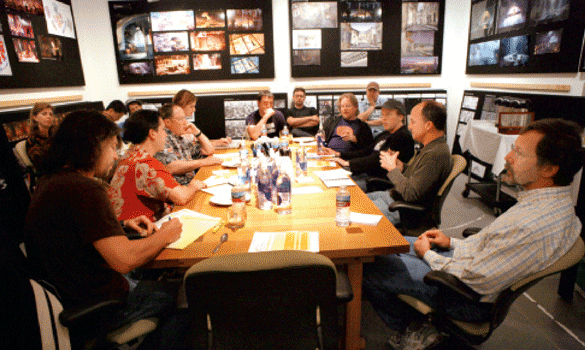An amended version of this article was originally published in Entrepreneur.
As a founder of multiple startups and current COO of Hightail, I’ve led many projects, from launching new websites to rebranding a multi-billion dollar global company. While I’ve had some great wins, I don’t mind admitting that there have also been a few disasters.
A runaway success often seems like the result of some arcane alchemy, but in my experience failure is rooted in the same recurring problems. I’m going to highlight five of these mistakes and the lessons I’ve learned about avoiding them in future projects.
1. Eyes are bigger than your budget
We’d all love to run a Super Bowl ad but you can’t do it on a shoestring. Businesses need goals, even dreams. You just have to temper them with a healthy dose of reality and expectation setting, so that it’s clear what you can actually achieve given your available time, resources and budget.
Recognizing your constraints can lead to unexpected benefits. When the founders of 37 Signals began work on their signature product, Basecamp, they made an honest assessment of how much time each person could invest. As most of the founders still had full-time jobs, their time constraints forced them to develop a feature-lite project management tool. This simplicity turned out to be one of the major factors behind the success of the app.
To avoid misaligning dreams with reality, your business needs a culture of honest communication that encourages clear-sighted discussion across all levels instead of just having unquestioned orders flow downstream.
2. Working with the wrong talent
Whatever the project, a company’s first instinct is to put an in-house team on it. After all, that’s what they’re there for, right? But just because someone is part of your company doesn’t mean they’re the right person for a specific project.
I used to run a startup that made games and 3D animations. We had a full-time staff member whose job was solely to find external talent. If we needed CG lighting, he’d call a Kuala Lumpur-based animator because he was the best lighting guy we knew. Our aim was always to find the right person for a project and not just who was available in-house.
The key is to be honest with yourself and your employees and, if necessary, look outside your core team to find the best people for a project. Start building relationships now with agencies, contractors and consultants so you have a network ready to fulfill specialized tasks when the time comes.
3. Continuing to pursue bad ideas
In Hollywood, they say it’s easy to make a bad film from a good script but impossible to make a good film from a bad script. Though you won’t always recognize a bad idea straight away, once you do, never assume that you’ll make it work or believe that you’ve put in too much effort to change course.
I once worked with an external agency on a series of digital ads but after a number of designs, tweaks and iterations, I still couldn’t convince myself that we’d hit gold. Eventually I realized that the visual approach we had agreed upon at the beginning of the project was wrong. After we decided to start over and work with a new set of stylistic references, the project came together very quickly.
The minute you recognize that an idea won’t work, you have to pull the plug. It’s usually impossible to retrieve a bad idea and you’ll only waste time, money and energy trying to put lipstick on a pig.
4. Death by committee
A project often has multiple parties interested in its outcome and groups may even have divergent goals and expectations. I once spent weeks working with a designer and copywriter on a website home page redesign, only to have our carefully-crafted work dismantled by the company’s various heads of department demanding changes to meet their individual needs. Our problem was that we failed to establish who owned the project and therefore didn’t deal with potential conflicts and disappointments in advance.
Renowned animation studio Pixar has a large group of people it calls the “brain trust” that meets to review films at different stages of production. Though the committee’s job is to provide notes on potential problems and offer solutions, none of the advice is mandatory. The film’s director retains complete control over the final product.
Feedback is an essential stage of any project. But decision-by-committee rarely leads to best outcome. Every project should start by establishing clear, workable goals and give one person the ultimate ownership and accountability for meeting them.
5. Keeping the final approver in the dark
Typically the bulk of work on a project happens below the level of the final approver. You often get a situation where, for example, a freelancer works closely with their contact at a company to complete a piece of work, only to hear the dreaded words: “now I just have to run this past my boss”. I call this “the contractor’s nightmare”.
As someone who is often the “boss”, I find it remarkable if the first thing I see is the “final” version and I’m just expected to give it a thumbs-up. In reality, my first experience of a project is likely to produce lots of questions, comments and suggestions. While I don’t believe in micromanaging talented people, being able to review a project at certain set stages makes for a better overall process. I’d much rather give feedback on a plan sketched out in a day than reject weeks of hard work if it’s not good enough.
When beginning a project, establish clear checkpoints for the ultimate approver to provide feedback. This will help ensure a smoother path to the finish line.
These are the five most common causes of why projects fail. Applying these suggested pre-emptive strikes and remedies should help you avoid catastrophe on your next big project. If you have solutions to other common project mistakes, I’d love to hear them in the comments.
If you like this, try:
Eight tips for better teamwork
Tear down this collaboration firewall
Five alternatives to meetings






The item that resonates with me the most is what (in the public sector) we called Death by Committee. Two entrepreneurial projects I recall like recurring nightmares transpired because a committee and a board convinced themselves the projects were good ideas. A political associate used to say: “When all think alike, none think very much.”
Great article. Thanks for the reminders.
Thanks, Mike. I read this article with interest. You’ve put together some very useful ideas and tips for successful project-making and collaboration! All the best, Astra.
Very valid, informative and important points…digested this complete post, thanks so much! Was worth the read.
Item 5 resonates with me.
When I was working for an ad agency, we used to create ads to a highly finished state only to be shot down by the Big Boss. This was in the age BC (before computer) when there were no stock photos or digital prints, and everything had to be crafted by hand.
The belief then was that some bosses had no imagination to understand a rough concept sketch. It was a very expensive way of shooting in the dark.
This is a very nice post with tips to cut through the red tape of projects involving multiple hands in the mix. You see a lot of these types of lists but they are usually long winded and I skip through the headlines as “self-explanatory” – I admit to skimming 1-3 but took the time to read 4 & 5 and that made this whole thing worth it. 1-3 are simple “obvious” causes but 4 & 5 can be related to and readers can incorporate into those situations. They also give easy concise answers to avoiding the issues at the start of the project
We are in the process of a website redesign. Having been down the project road many times in the past – I can say that this list is right on and serves as a timely reminder for me. Thanks for encapsulating it so well!
Hit the nail on the head on why projects fail. A project that should have a focused core management group gets caught in the corporate blender and soon looses focus, timelines extended and when the project goes “south” the rats that caused the failure are first off the ship, pointing fingers.
Awesome!!
Excellent advice ! I’ve been in charge of many projects and your 5 points all ring very true. Very concise and helpful tips. Thanks !
Amen!
Thanks for your perspective on why projects fail. I recently left a company that produced online interactive training as a project manager and found our biggest project mistakes came from not dealing consistently with ‘scope creep’ – whereby internally and externally we were challenged to deliver a high quality product within the scope of the project as agreed to by everyone involved. With our customers, it was difficult keeping them in line with what they agreed the final deliverable would look like based on the scope of the project. And, from a customer service perspective, we found ourselves continuously saying, ‘sorry, that’s out of scope’ even though some of the suggestions would have improved the final product. Also, asking the customers to pay more for what seemed like a legitimate request could strain the relationship moving forward. Internally, we struggled with wanting to do more for the project to deliver a better product but knowing the customer wouldn’t pay for the improvements sometimes held us back. And, the owner of the company was not fond of giving more without charging for it. As the project manager, you are the chief negotiator between the client and your internal team. The key to successfully managing scope creep is continuous communication and clearly identifying when key milestones are reached within the statement of work. When customers ask for something out of scope, rather than say no it’s time to negotiate and find ways to shift outcomes while staying on budget. When you clearly communicate the effort needed to meet a change in scope I find customers respond positively by either finding the budget or agreeing that the change is not possible. Internally, the creative team likes to ‘sneak’ in a few improvements that didn’t take very long to do. However, any amount of effort above the initially agreed upon time to spend on the project costs the company money. I found that allowing the internal team the flexibility to propose better ideas without an immediate no and presenting these ideas constructively to the client gave them the creative license to find ways to deliver a better product within budget. They were challenged to ‘make it happen’ within the scope of the project and narrowed their focus to deliver their best efforts without just delivering ‘something’ to finish the job. So communicate continuously with your customer at the first sign of scope creep, clearly outline the effort and challenges around changes in scope to avoid conflict and allow your internal team some flexibility without stifling the creative process. We all want our project deliverables to be of the highest quality, have measurable results and most importantly be profitable.
Excellent explanations of how these 5 items truly pan out. Other people write on these subject but never put it in a real terms of how it relates to a failed project. Thank you for this article.
Great article!
Excellent reminders for hard earned lessons!
Yes very correct advice for people starting new ventures
The Founders of any projects must have the practical experience about the project they intend to establish,for example if you want to establish cattle and sheep farm to produce meat & Milk,you must had the experience in buying the breeds,the feed…etc, otherwise you will lose and also let the experts control everything.
Another important point is to detect potential problems with psosibles priori ways of solution to reach the end result. In this sense, perseverance is an important factor of success in addressing problems not considered a priori. My advice is always considered for future projects a cushion of time (period of grace before product deployment) allowing imponderables handle problems that were not considered. Take a deep breath and move on without desilucionarse or leave the project unfinished. This happened to me with the music video that we created and produced with my friends and they taught me the hard process of persevering to the end. This is the video: http://youtu.be/fXhLB4rbi0g
Thanks a lot for this article. Big Huge!
Mike a very interesting article highlighting many valid points. In my forty years experience I would add one or two more factors which are critical to be aware of, equally they are difficult to deal with. Identify in the short term protectionism it’s a totally negative element. Often perpetrators are insecure and unfortunately undermine potential development in trying to secure their own position.
Extremely true to the core. This hits home! I certainly hope this list gains many readers.
Great notes – thanks
this is great stuff for start-up, its loaded with wealth of knowldge from experince
I remember an old adage: “A camel is a horse designed by a committee.”